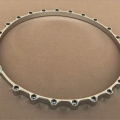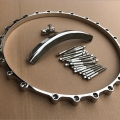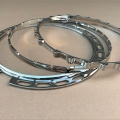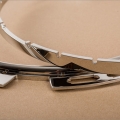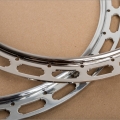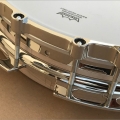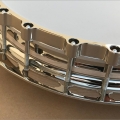New prucha POT METAL TENSION HOOP AND TOP TENSION HOOP
Back in 2014 I poured the first batch of our Reissue Prewar Specs One Piece Flange (see BNL March 2015). I was happy and satisfied but also tired and exhausted, after more than a year of hard work. And when I say exhausted, I also mean exhausted financially, because the cost of the new mold that had to be made was quite high, taking into account the size and revenue of our company. I could have been satisfied, especially after we had eliminated some problems and perfected the nickel-plating process. Nickel plating, by the way, can be a nightmare, but by improving our procedures and technology we have reached a very high standard. Judging from conversations with experienced music instrument makers, I know that most of our customers have no idea how many operations and how miuch prep work needs to be done, with nickel plating in particular, and especially how many times I must handle a single flange in the manufacturing process. A recent visit to see Jim Mills woke me from my self-satisfied hibernation. We were sitting in Jim’s showroom, picking his prewar Gibsons and chatting about our new flange. He closely inspecting our product and was generous with his praise. “Hey Jarda,” he said, “have you ever considered producing pot-metal tension hoops?” I remember feeling dizzy. I thought I might have misheard him, and after my heartbeat got back to normal, our debate unfolded intoan analysis of how one might produce a tension hoop mold.
The vast majority of Gibson banjos from the late 20’s and 30’s utilizing one-piece zinc flanges also featured pot-metal zinc tension hoops. This fact remains the main incentive supporting our decision to initiate prewar reissue tension hoop production. Period.
“Jim Mills here…of Jim Mills Banjo Inc…and although I deal exclusively in Original Pre War Gibson Banjos and Parts, I have closely followed Jarda Prucha in all his endeavors into creating the very best Pre WWII-era replica banjo parts on the market…and in my opinion there is none better in quality or workmanship.”
Back in the day, the Gibson factory introduced both zinc cast one-piece flanges and tension hoops as part of cost saving measures. These new parts were also easier to manufacture. Pot-metal tension hoops were a little less heavy then their brass predcessors. The total weight of a banjo is often a hot topic in the banjo community—does it affect the sound? Do pickers prefer lighter or heavier banjos? We don’t know the definitive answers, but we know for sure that there is a big group of players, luthiers, collectors and other banjo geeks who just prefer pot-metal cast tension hoops on their instruments. Prewar-era tension hoops had their drawbacks. The early versions, especially, had a tendency to warp or break, and engravings and nickel or gold plating were not easy to apply on zinc alloy, and didn’t last long. On the other hand, warping and breaking was often caused by bad manipulation—overtightening the hide head and/or frequent adjustments of the head tension, but also by the poor quality of the metal plating and by mistakes in the pouring process; adding too much lead to the alloy, for example. Being aware of all the above-mentioned pitfalls, I made sure to assess all the pros and cons by learning as much as possible from respectable and experienced experts in the banjo community—Jim Mills, Steve Huber, Paul Hopkins and Eric Sullivan, etc.
“Gibson switched from brass tension hoops to pot metal—a change that was most likely cost-driven—on many models in 1929. Many true prewar aficionados prefer the pot metal tension hoop. Mr. Prucha has done a fine job with his new pot metal hoop and I’m proud to use them on my banjos.” - Steve Huber
So here I was again, facing another big, financially-demanding challenge. I returned home to Czech Republic with a decision I had to make.... The first thing I decided was to make a phone call to Vlada Ptacek, my current supplier of brass hoops. Would he also like to produce the zinc hoops for me? His answer was no; he was clearly aware of the investment that needed to be made. So okay, he didn’t make my day any better.... Still hesitant, I started to measure the prewar tension hoop sample we had bought from Jim Mills. Pondering about the new blueprint, I have finally made the decision to kick off the project. The company that originally made the flange mold for us came up with even higher estimate for the new tension hoop mold. I had to inquire somewhere else. I addressed several companies competent in producing molds for zinc pressure casting, but all offers were much too pricey. Eventually, driven by our experience with the one-piece flange project, I decided to sign up with a company that had no previous experience with the production of similar molds, resulting in lower expenses but also necessitating my personal involvement in the project. My involvement meant responsibility for calculations of contraction tolerance, design of sprues and venting holes or overflow wells, etc. History repeated itself; the assigned engineer (an expert in zinc casting) didn’t take into account my previous experience and “feel,” and designed the mold by himself. That mold didn’t work out, and had to be re-designed (without the assistance of the assigned engineer) according to my initial proposal. This complication meant a delay of several months, but the final result was excellent. Small improvements repaired small issues with porosity of the casting, and then the final product was up to our standard of quality.
“Thanks for the hoop. If you truly want the old pre-war sound of a mid 30’s flathead, you need the pot metal hoop!!” - Paul Hopkins
Into the mold construction, I included interchangeable inserts of different shapes which have been a big asset for our other projects. After pressing our two initial pourings, I defined the processes for inner and outer machining, buffing and final copper flashing and nickel plating. The tension hoop production was finally on its way. The more I immersed myself into the project, the more challenges I found. In my profession I’ve always noticed a shortage of top-tension hoops. Top-tension banjos were historically produced in very limited quantities and therefore no one ever came up with a top-tension mold. Producing these parts by machining a bulky piece of material is extremely complicated. I decided to reach even deeper in my pocket and pay for production of another mold insert in the shape of a top-tension hoop. I was lucky that I could inspect the original prewar top-tension flathead banjo owned by my friend, collector and picker Martin Mikulas, who purchased it several years ago from the famous Dick Smith. Again, the measuring took a while, but having the previous experience with the flange preparation work we had a lot to build on. My essential goal was to produce my top-tension hoops as close to the prewar original as I could get. After several months of work, I can say I am very satisfied with the results, and am glad we can satisfy the builders, players and fans of top-tension banjos. After the initial investment into the molds, our financial burden was not over. To make the production process effective we had to make 400–600 prints from each pouring, which takes approximately one shift in a factory. Companies producing spare parts for the auto industry wouldn’t even rent their manufacturing press line for a shorter period of time. People might not realize how much money we had to invest into raw pressings; these unfinished products lay stockpiled in our workshop waiting for further treatment and finishing for months. Only after they are sold can we hope to get our money back.... I’m certain that the final price tag of a flange or tension hoop should be at least twice as much as it is today, as well as the price of new banjos made by renowned producers, but persisting overproduction of cheap Korean or Chinese parts and instruments push the value of quality instruments down. I often wonder why this mass overproduction has influenced the customers who are willing to overlook immense optical, functional and also acoustic flaws of these so-called instruments.
Jarda, building banjos with your parts is much easier. Thanks! - Eric Sullivan
But to be positive, we can assure our fans and customers that due to the extreme quality of our molds, our products will be available at the market even in 20 years from now. The production has been slowly taken overby my son Jan, who has become an integral part of our company. Mostly, all reputable producers of top-quality instruments have been using our parts and components, so in the future it will not be a problem to buy or change any damaged or defunct part.


